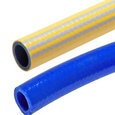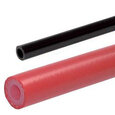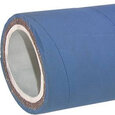Food-Grade Hose Guide & Standards
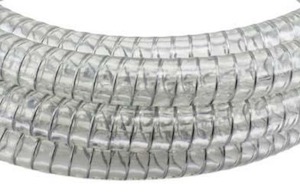
Figure 1: Food-grade PVC hose
Food-grade hoses play a vital role in ensuring the safety and quality of food and beverages produced. Organizations such as HACCP, FDA, CDC, and SHIPSAN enforce regulations to prevent product contamination. Food-grade hoses are made from flexible materials like polyurethane, PVC, and thermoplastic rubber. Each material has advantages and disadvantages, making it essential to choose the proper hose for each application, including the transportation of highly fragrant products. This article discusses the main features, materials, certifications, and applications of food-grade hoses.
Table of contents
- Why do I need a food-grade hose?
- Food-grade certifications and regulations
- Food-grade hose materials
- Selection criteria
- Applications
- FAQs
View our online selection of food-grade and other hoses!
Why do I need a food-grade hose?
Food safe hoses enable the safe and hygienic transfer of liquid and dry bulk food materials. These hoses protect food products from external contaminants during the transfer. Because these hoses come into contact with food products, it is crucial to use the appropriate hose material to prevent any contamination of foreign substances into the food products. Therefore, the hose must adhere to specific standards to avoid deterioration that could potentially impact the quality, aroma, purity, or taste of the food products flowing through them. While they may look like other types of hoses, food processing hoses differ from them in the following ways:
- Non-toxic, non-metal construction: Plastics and rubbers offer inherent corrosion resistance, making them ideal for food and beverage operation equipment. Metal components, excluding stainless steel, are often susceptible to corrosion, which contaminates food products.
- Excellent durability: Food-grade hoses are designed to withstand the harsh conditions of food processing facilities (e.g., high temperatures, pressures, and abrasion).
- Pressure capacity: Many food processing operations maintain various pressure conditions. A wide variety of food-grade hoses is available on the market suited for use in vacuum and pneumatic applications.
- Odorless/tasteless design: The food-grade hoses are designed not to add odors to products, contamination, or flavors to the conveyed material, nor does it absorb odors. This helps keep the taste and aroma of the final product intact.
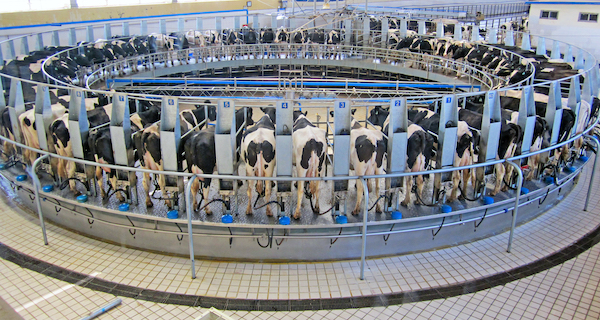
Figure 2: Food-grade hoses find extensive use in milk production.
Food-grade certifications and regulations
Food-grade hoses should comply with various standards, regulations, and certifications.
ISO 22000 - EU
ISO 22000 sets the requirements for food safety management. It illustrates what an organization needs to do to control food safety hazards to ensure food is safe for consumption. Any organization can use it regardless of its position or size in the food chain. Although this certification is not explicitly intended for hoses, it does cover the broader area of specifications closely involved. Companies and their processes can be audited, certified, and registered in compliance with ISO 22000 by 3rd parties. For example, in Germany, the Control Union Certifications are accredited for FSSC 22000. FSSC 22000 ensures a company adheres to ISO 22000/9001 requirements and provides a certification scheme for food safety and quality management systems.
Regulation (EC) 1935/2004 - EU
(EC) 1935/2004 - EU is a European regulation that governs materials and objects, including plastic, rubber, metal, and silicone hoses, intended for contact with food and beverages.
FDA, 21 CFR177.2600 - USA
In the United States, the FDA, or Food and Drug Administration, has several regulations that deal with plastics, rubbers, and metals that come in contact with food and beverages. One of these regulations is CFR177.2600. This regulation deals with rubber and rubber-like compounds and whether or not they are suitable for food-grade components.
Food-grade hose materials
Food-grade hoses are made from flexible materials, such as polyurethane, polyvinyl chloride (PVC), and thermoplastic rubber. Additionally, they have an internal spiral wire made from stainless steel that provides strength and durability to the overall assembly.
Thermoplastics
Thermoplastic hoses are made from flexible plastic polymer materials tolerant to heat and chemicals. These hoses are suitable for transferring and processing various liquid food products, juices, beer, wine, water, pastes, and syrups. The primary materials under this category are polyurethane, PVC, and PTFE.
Rubber
The durability of rubber food-grade hoses makes them excellent for demanding, heavy-duty food transfer applications. Like thermoplastic hoses, rubber hoses are designed to handle the suction and discharge of various liquid food products and edible grains. The most common rubbers used are NBR and EPDM.
Stainless steel
Stainless steel is an excellent alternative for applications that do not require flexible hosing. Stainless steel is easy to clean and widely used in the food and beverage tube industries. Typically, the material meets and exceeds the requirements of food and beverage safety standards.
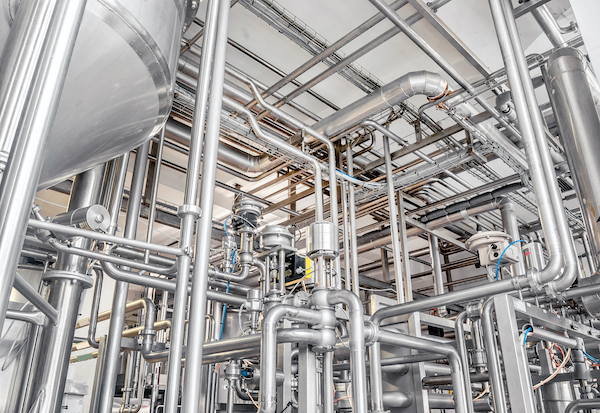
Figure 3: Stainless steel piping used in beverage and food-processing facilities.
Selection criteria
A good quality food-grade hose will not merely transport food, but it will preserve its integrity and quality during the process. When selecting food-grade hoses for a particular application, there are several factors to consider to ensure that the hose is safe, effective, and compliant with regulatory requirements.
-
Material composition and regulations:Common materials used in food-grade hoses include PVC, silicone, rubber, and polyurethane. The material should be compliant with FDA, USDA, or other applicable regulations for food-grade products.
- Food-grade hoses used in the UK and Europe must comply with the standards outlined in (EU) No.10/2011 and (EC) No.1935/2004 for food contact applications.
- Food hoses intended for transferring drinking water must also be approved by NSF51 and NSF61.
- In the US, food-grade hoses must be made from materials that are FDA-approved.
- Temperature: For high-temperature applications, materials such as silicone, EPDM (ethylene propylene diene monomer), and PTFE (polytetrafluoroethylene) are commonly used due to their ability to handle temperatures up to 400°F (204°C) and sometimes higher. For instance, silicone hoses are widely used in baking, candy making, and other high-temperature food processing applications. For low-temperature applications, materials such as PVC, polyurethane, and rubber are commonly used due to their ability to handle temperatures as low as -40°F (-40°C).
- Pressure: Choose a food-grade hose with a pressure rating that matches the pressure requirements of the application. For example, a high-pressure hose may be required for transferring thick or viscous liquids, while a low-pressure hose may be suitable for transferring thin liquids, such as water or beer.
- Flexibility: Flexible food-grade hoses are easier to install and are less likely to break, which can prevent contamination of the food or beverage being transferred. Flexible food-grade hoses are typically made from materials such as silicone, PVC, and polyurethane, and they can be reinforced with wire or other materials to enhance their flexibility and durability.
Applications
Food-grade hoses are utilized in any situation where food or drink must be moved from one location to another. They can be found not only in food processing facilities but also in other settings such as pubs, restaurants, and breweries. Additionally, food hoses are used in the pharmaceutical industry due to their capacity to transfer substances without affecting their aroma or taste. Table 1 shows standard food-grade material hoses, temperature range, and typical applications.
Table 1: Standard food-grade material hoses, temperature range, and typical applications
| Material | Application | Temperature range |
| PVC | Ideal for applications where pressure and temperature are limited, such as drinking water, soft drinks, and various raw materials. PVC hoses are transparent, lightweight, and flexible. | -20 𐩑C - 60 𐩑C (-4 𐩑F - 140 𐩑F) |
| PTFE | PTFE hoses are ideal where temperature, pressure, or movement are high—used for filters and centrifuges, fragrances, and flavorings. PTFE has excellent chemical resistance and is typically easy to clean. | -70 𐩑C - 260 𐩑C (-94 𐩑F - 500 𐩑F) |
| Polyurethane | Hoses made of polyurethane are used with dry and abrasive foods. Polyurethane is resistant to fatty foods and is suitable for dry ingredients such as spices and milk powders. | -40 𐩑C - 90 𐩑C (-40 𐩑F - 194 𐩑F) |
| NBR | For applications needing oil and greaseproof material. Among other applications, NBR hoses are used with dairy products, oils, mayonnaise, and soft drinks. | -30 𐩑C - 100 𐩑C (-22 𐩑F - 212 𐩑F) |
| EPDM | EPDM hoses are commonly used for drinks and juices. Beverages such as beer, soft drinks, and wine are also used with EPDM hoses, which can also be used for high-alcohol beverages. | -70 𐩑C - 260 𐩑C(-94 𐩑F - 500 𐩑F) |
| Stainless steel | Used almost exclusively for applications with high temperatures. Typically expensive to use but offers unmatched reliability, is easy to clean, and can be used for nearly all products. | -100 𐩑C - 300 𐩑C (-148 𐩑F - 572𐩑F) |
FAQs
What makes a hose food grade?
A hose is considered 'food grade' if it meets certain criteria and standards that make it safe for food processing and handling applications.
Is polyethylene tubing safe for drinking water?
Yes, but ensure the tubing is labeled as 'NSF-61' or 'NSF-PW' certified. This means that it has been tested and approved for use in potable water applications by the National Sanitation Foundation (NSF).
What is a food-grade water hose?
A food-grade water hose is designed for use in food and beverage applications where the hose will come into contact with potable water. They are typically constructed of materials like PVC, polyurethane, or rubber approved by regulatory bodies like the FDA.
Is vinyl tubing food safe?
Vinyl tubing can be suitable for some food and beverage applications, but not all vinyl tubing is rated for use with food and potable water.
What is an FDA-approved plastic?
The FDA provides guidelines for food contact materials, including plastics. Some plastic types that are commonly used for food packaging and have received FDA clearance include Polypropylene (PP), Polycarbonate (PC), and Polyethylene terephthalate (PET or PETE)




